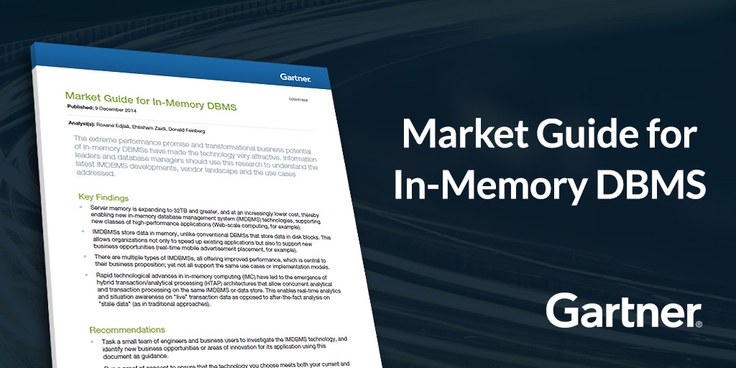
From the inception of SingleStore, we’ve seen the ability to merge transactions and analytics into a single database system as a core function for any data centric organization. Gartner’s recent report, “Market Guide for In-Memory DBMS” mirrors that belief, and is chock full of key findings and recommendations for businesses looking to take advantage of in-memory computing.
Skip this article and download a complimentary copy of Gartner’s Market Guide for In-Memory DBMS
In the report, Gartner found that “rapid technological advances in in-memory computing (IMC) have led to the emergence of hybrid transactional/analytical processing (HTAP) architectures that allow concurrent analytical and transactional processing on the same IMDBMS or data store.”
HTAP Solves for Real-Time Data Processing
HTAP promises to open a green field of opportunities for businesses that are not possible with legacy database management systems. Gartner highlights that with HTAP, “large volumes of complex business data can be analyzed in real time using intuitive data exploration and analysis without the latency of offloading the data to a data mart or data warehouse. This will allow business users to make more informed operational and tactical decisions.”
HTAP Use Cases
We are in the early days of HTAP, and it is not always clear how it can be applied in the real world. As a rule of thumb, any organization that handles large volumes of data will benefit from HTAP. To provide a bit more context, we’ve compiled the following applications of HTAP in use today.
Application Monitoring
When millions of users reach mobile or web-based applications simultaneously, it’s critical that systems run without any hiccups. HTAP allows teams of system administrators and analysts to monitor the health of applications in real-time to spot anomalies and save on costs incurred from poor performance.
Internet of Things
Applications built for the internet of things (IoT) run on huge amounts of sensor data. HTAP easily processes IoT scale data workloads, as it is designed to handle extreme data ingestion while concurrently making analytics available in real-time.
Real-Time Bidding
Ad Tech companies struggle to implement complex real-time bidding features due of the sheer volume of data processing required. HTAP delivers the processing power that’s necessary to serve display, social, mobile and video advertising at scale.
Market Conditions
Financial organizations must be able to respond to market volatility in an instant. Any delay is money out of their pocket. HTAP makes it possible for financial institutions to respond to fluctuating market conditions as they happen.
In each of these use cases, the ability to react to large data sets in a short amount of time provides incredible value and, with HTAP, is entirely possible.
Finding the Right In-Memory DBMS
Before diving into a proof of concept, we highly suggest reading Gartner’s “Market Guide for In-Memory DBMS.” By giving it a quick read, you’ll come away with a better understanding of the in-memory computing landscape, new business opportunities, applicable use cases for your organization, and an action plan for getting started.
For a limited time, we’re offering a complimentary download of the report. Download it now to learn:
- Why In-memory computing is growing in popularity and adoption
- How IMDBMSs are categorized and the three major use cases they support
- New business opportunities emerging from hybrid transactional and analytical processing (HTAP)
- How to jump ahead of the competition with recommendations for effective use of IMDBMS
Get a better understanding of the in-memory computing landscape. Download the Gartner Market Guide here. – Click to Tweet
Required Disclaimer: Gartner does not endorse any vendor, product or service depicted in its research publications, and does not advise technology users to select only those vendors with the highest ratings or other designation. Gartner research publications consist of the opinions of Gartner’s research organization and should not be construed as statements of fact. Gartner disclaims all warranties, expressed or implied, with respect to this research, including any warranties of merchantability or fitness for a particular purpose.





